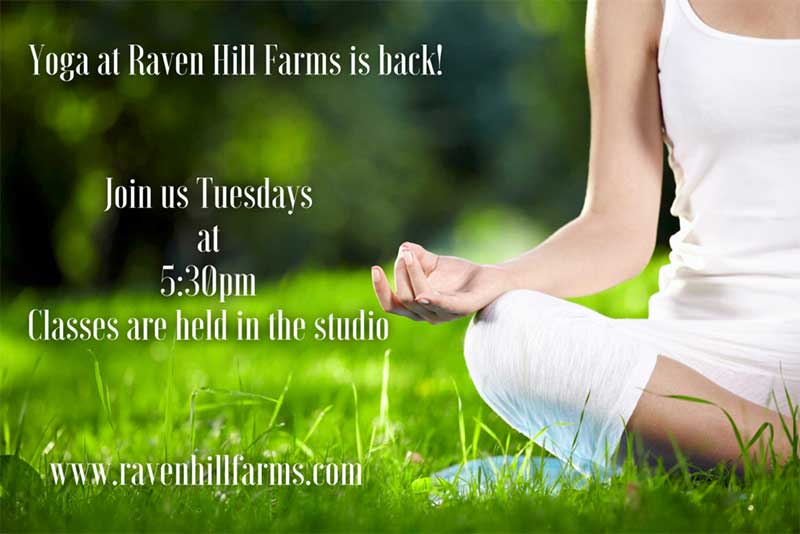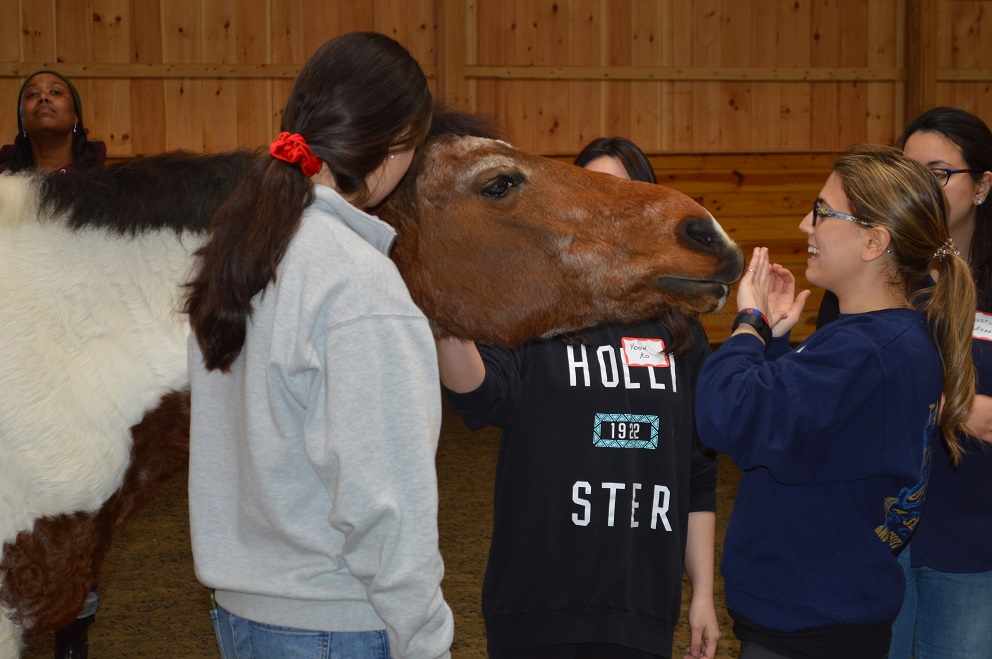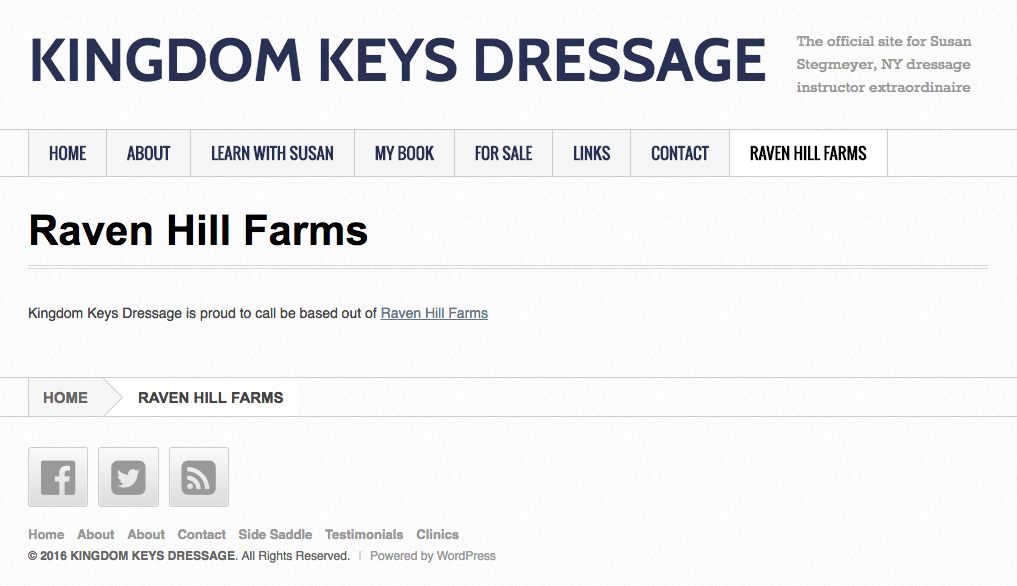Raven Hill Farms in the News

 Warwick Valley School District students attend Leadership Training at Raven Hill Farms
Warwick Valley School District students attend Leadership Training at Raven Hill Farms
Warwick Valley School District students attend leadership training at Raven Hill Farms
WARWICK — Recently 27 students from The Leadership Academy at Warwick Valley School District had the unique opportunity to attend six sessions of leadership training at Raven Hill Farms.
Equi Power Solutions@ Raven Hill Farms is an equine experiential education program where students participate in non-riding activities with horses designed to develop essential life skills to make more informed choices and creating positive outcomes through respect, responsibility and integrity.
Owner Deirdre Hamling said that students learn to communicate more effectively, develop critical thinking skills, increase self-worth and demonstrate positive relationship skills. And through the progressive sessions the students are able to identify and strengthen their leadership traits, enhance their team building skills, develop awareness of their coping mechanisms and fine tune their critical and creative thinking.
Each session is developed and facilitated by Hamling along with clinical psychologist Bonnie Malajian and horse specialist Susan Stegmeyer.
“Horses are animals of prey that have been hunted by predators for centuries,” said Hamling. “Therefore, they are acutely and highly attuned to every aspect of the world around them. They are instinctive and their very survival depends on their ability to interpret the energetic and emotional currents in their environments.”
The final session focused on perseverance and was kicked off with a demonstration ride by Para-Olympian Donna Ponessa who personifies the term by overcoming obstacles and setbacks to compete in the London Games. Her disability is a rare autoimmune disorder that attacks the spinal cord and optic nerves. The disease is progressive and has left her paralyzed from the chest down with limited use of her hands and arms.
Ponessa also gave the students a motivational talk on her journey and her accomplishments. The students were spellbound during both her ride and speech.
“The people at Raven Hill,” said student Kaeli Thompson, “were so nice and encouraging and it was great that we could learn about the qualities of leadership through something as unique as horses.”
Raven Hill Farms is a full service equestrian center offering programs for schools, corporations and individuals in team building, authentic leadership and personal and professional development.
Additional information about the farm and the Equi-Power programs can be found at ravenhillfarms.com or by calling Hamling at 845-987-6965,
Medical students enhance patient skills by interacting with horses
The exercise at Raven Hill Farms in Warwick is to understand the value of non-verbal communications
Photos

Photo by Roger Gavan
Eighteen first- and second-year medical students from The Touro College of Osteopathic Medicine in Middletown along with their professor, Dr. Alex Joanow (second from left), Director of Development Deirdre Hamling (far right) and staff recently enjoyed an unusual and intriguing afternoon at Raven Hill Farms, a local horse farm in the Town of Warwick.
Photo (below) by Roger Gavan
 The session at Raven Hill Farms began in a newly constructed conference room with an overview of the program, a review of horse dynamics, and an emphasis on learning in a non-judgmental, open ended and fun manner. Facilitators included Director of Development Deirdre Hamling (speaking center), owner and operator of Raven Hill Farms, equine specialist Susan Stegmeyer and licensed clinical social worker Bonnie Malajian. Following the introduction, the group moved to the large indoor arena where five horses of different shapes, sizes, and temperaments were the focus of the students to use their observation skills to interpret the horse’s behavior. Breaking into smaller groups the students chose the horse they preferred to work with.
The session at Raven Hill Farms began in a newly constructed conference room with an overview of the program, a review of horse dynamics, and an emphasis on learning in a non-judgmental, open ended and fun manner. Facilitators included Director of Development Deirdre Hamling (speaking center), owner and operator of Raven Hill Farms, equine specialist Susan Stegmeyer and licensed clinical social worker Bonnie Malajian. Following the introduction, the group moved to the large indoor arena where five horses of different shapes, sizes, and temperaments were the focus of the students to use their observation skills to interpret the horse’s behavior. Breaking into smaller groups the students chose the horse they preferred to work with.
Photo (left, below) provided by Deirdre Hamling
WARWICK — Eighteen first-and second-year medical students from Touro College of Osteopathic Medicine in Middletown, along with their professor and staff, recently spent an unusual afternoon at Raven Hill Farms, a local horse farm in the Town of Warwick.
The students participated in an innovative training program designed to transform the doctor-patient relationship.
Raven Hill Farms, situated on 36 acres, is home to Equi-Power Solutions, an equine experiential learning program for personal and professional development.
On Friday, March 11, the students took part in the Medicine and Horsemanship program, created to enhance the health care professional’s awareness of non-verbal communication skills to more effectively connect with patients.
The program was originally developed by Dr. Beverly Kane and Dr. Allan Hamilton and initiated at Stanford University in 2005.
The program has expanded around the globe and is incorporated into the curriculum at Mass General University, UCSF, and University of Arizona to name just a few.
The session at Raven Hill Farms began in a newly constructed conference room with an overview of the program, a review of horse dynamics and an emphasis on learning in a non-judgmental, open-ended manner.
Facilitators included Director of Development Deirdre Hamling, owner and operator of Raven Hill Farms, equine specialist Susan Stegmeyer and licensed clinical social worker Bonnie Malajian.
Following the introduction, the group moved to the large indoor arena where five horses of different shapes, sizes and temperaments were the focus of the students to use their observation skills to interpret the horse’s behavior.
Breaking into smaller groups the students chose the horse they preferred to work with.
As they groomed the horses they became aware of how their approaches needed to differ from horse to horse and were surprised by how much their intention effected the reactions of the horses.
In the second exercise, the group was asked to construct a pathway out of various poles, rubber cones and assorted balls that would represent their journey through medical school. And his or her task was to get each horse to travel the pathway without the help of any halter or lead ropes.
Each and every moment was filled with learning opportunities that were later discussed when the students returned to the conference room, where there were numerous comparisons of how the horses behaviors mirrored the intention of the students, often in remarkable ways.
These moments were designed to enable the students to discover how their actions, whether conscious or unconscious, played a pivotal role in their relationships with their patients as well as with the other students.
“As prey animals,” said Hamling, “horses are sensitive to everything they see, hear and feel which can be interpreted by understanding their body language. We might even refer to them as living, breathing biofeedback machines.”
The skills learned working with horses, she explained, help participants build confidence, mindfulness and emotional intelligence.
“Interacting with horses,” said Hamling, “enables us to learn clear and effective ways to build trust and gain respect. Their cooperation with the students was based on a number of factors, such as rapport, trust, clear communication, patience, tone, body position, eye contact, respect of boundaries and how, if and when to touch. It is clear that these are the very same factors that enable patient compliance, cooperation and improved outcome.”
The entire program was embraced by all the students.
“This was an exciting, interesting and unique educational opportunity for the medical students from Touro College of Osteopathic Medicine,” said Dr. Alex Joanow, a founding partner of Horizon Family Medical Group and adjunct clinical assistant professor at Touro College. “It provided an experience to develop communicative skills that hopefully, the students will use throughout their careers. It certainly melds with the holistic philosophy that is the foundation of osteopathic medicine.”
In addition to this program, Equi-Power Solutions offers corporate development, team building and leadership workshops as well as personal development sessions for individuals, couples, families and groups. All sessions are unmounted, interactive, solution-based with no previous horse experience necessary.
Raven Hill Farms is a private riding club and home to Jockey Hollow Pony Club as well as a full service equine boarding and training facility.
For additional information contact Hamling at 845-987-6965.
 Yoga is back! Class is now being held Tuesdays at 5:30pm. Join us in our renovated yoga studio in the cottage.
Yoga is back! Class is now being held Tuesdays at 5:30pm. Join us in our renovated yoga studio in the cottage.
https://www.instagram.com/p/BFW5mFdtj1g/

 STRAIGHT FROM THE HORSE’S MOUTH
STRAIGHT FROM THE HORSE’S MOUTH
Unique program helps medical students build nonverbal communication skills
TouroCOM-Middletown students learn to establish trust and recognize nonverbal cues through Medicine and Horsemanship program.
The five “patients” are scattered throughout the barn. A group of 18 student government leaders from Touro College of Osteopathic Medicine-Middletown (TouroCOM-Middletown) enters the corral, deciding which one to approach. Will it be the chestnut Warm Blood, the majestic Clydesdale or the miniature horse?
As participants in the Medicine and Horsemanship program offered at Raven Hill Farms, students engage with horses as a way to increase their awareness of nonverbal communication and its importance in the physician-patient relationship.
Why horses?
“Horses are honest teachers and are very sensitive to everything they see and feel,” explains Deirdre Hamling, owner of Raven Hill Farms. “Our program provides medical students with an understanding of how nonverbal communications can impact relationships with patients.”
Researchers have even found that horses and humans display similar facial emotions when expressing fear, surprise and sadness. Learning to pick up on these nonverbal cues can help students better understand how to establish trust and respect with patients, Hamling explains.
An eye-opening experience
Alex M. Joanow, DO, an adjunct clinical professor at TouroCOM-Middletown, first presented the program to Kenneth J. Steier, DO, the school’s dean. “First- and second-year students have very limited exposure to patients. They’re stuck in classrooms, and this was an opportunity for them to start practicing important skills,” Dr. Joanow says.
Through the program, students participate in a series of activities ranging from simple grooming exercises to guiding horses through an obstacle course without using reins.
The program left a lasting impression on participants, with many noting it helped them improve their bedside manner.
“Not only did the program teach us how to better read our patients, but it also helped us think about different ways to approach our patients,” says Rajat Malik, OMS II.
Dr. Steier agrees.
“Working with the horses helped us learn to read body language and adjust our own mannerisms,” he says. “If you can make a skittish horse feel comfortable, you’ll be good at making patients feel comfortable.”

Medical students enhance patient skills by interacting with horses

Horses Can Read Human Facial Expressions
And they don’t always like what they see.
Kieran Doherty / ReutersLAUREN CASSANI DAVIS FEB 29, 2016 SCIENCE
Humans have been living and working with horses for more than 5,000 years, since the first domesticated equines had their teeth worn down by primitive bridles in northern Kazakhstan. Hands could not have built modern civilization without the help of hooves—to haul ploughs, pull carriages, march soldiers into battle, and carry messages of love and war across hundreds of otherwise-insurmountable miles.
An unlikely pairing of wily predator and one-ton prey, humans and horses have managed to successfully communicate across the species barrier because we share a language: emotion. Experienced riders and trainers can learn to read the subtle moods of individual horses according to wisdom passed down from one horseman to the next, but also from years of trial-and-error. I suffered many bruised toes and nipped fingers before I could detect a curious swivel of the ears, irritated flick of the tail, or concerned crinkle above a long-lashed eye.
Horses can read human emotions, too, often in uncannily accurate ways; alerting us to our sadness or nervousness, sometimes before we’ve even consciously registered it. As Herman Melville wrote in Redburn, “No philosophers so thoroughly comprehend us as dogs and horses.”
Today’s domesticated horse, Equus caballus, is a tamer version of the snorting, shaggy beast who once roamed the plains in the Ice Age; selectively bred over generations for agility and a human-friendly temperament. But horses’ ability to form complex social relationships stems from an older evolutionary legacy, of living in close-knit bands of five to 10. Within these bands, foals, fillies, stallions, and mares—who were the observant matriarchs, despite the males’ eye-catching flashy necks and noisy displays, as Wendy Williams notes in The Horse—all formed close emotional partnerships. Now, humans are part of the herd: Domestic horses respond to the tiniest change in tone of voice, quality of touch, or stiffness of their rider’s body.
The equine ability to read human emotion through sound and touch is exquisite. But horses can also read the expression on a person’s face—as a Biology Letters paper earlier this month confirmed for the first time. This sophisticated capacity has only ever previously been demonstrated in dogs—and even further disproves the myth (that I believed until now, despite riding for 15 years) that horses have bad eyesight. While horses can’t see color, and have a blind spot directly in front of them as a result of eyes positioned on the side of their head, their vision is actually more acute than domestic cats’ or dogs’.
The horses tended to look at angry faces out of their left eye, engaging the part of the brain where fear-provoking stimuli are processed.
A University of Sussex research team, led by Amy Smith alongside the veteran animal-behavior scientist Karen McComb, showed a group of 28 horses large photographs of man’s face making either a positive (smiling) or negative (angry, brows furrowed) emotional expression. The results showed that horses were able to automatically distinguish between the two expressions, and what they meant.
The horses tended to look at the angry faces out of their left eye—a response well-documented in horses and in dogs, indicating that an animal is engaging the right hemisphere of its brain where novel and fear-provoking stimuli are processed. The horses’ heart rates also rose more quickly when they were presented with the angry face. Being able to tell a smiling handler from an angry one is a useful skill for a domestic horse—being approached by a frown rarely results in happy consequences.
The authors speculated that horses may simply have been applying an ancestral ability to read the facial expressions of their own species “onto a morphologically different species,” in this case, humans. These same University of Sussex scientists found last year that horses have 17 distinct facial expressions—more than dogs’ 16, or chimpanzees’ 14—many of which are similar to humans’ 27 facial movements, like creased brows or eyes widened in fear. (So far, this method of coding facial expressions hasn’t been applied to wild animals, and those that aren’t part of humans’ evolutionary lineage.)
However, since the horses tested in this particular study came from riding schools, where they interact with humans all day every day, their face-reading ability may also have been learned within their lifetime. Previous research has demonstrated that familiarity was a significant factor in dog’s ability to recognize human expressions—they performed better when faced with their owners than with a stranger.
While these latest findings probably come as no surprise to those who work with horses on a daily basis, they are one more piece in the increasingly complex picture of the emotional language humans share with other species. Horses’ ability to read faces perhaps also refines the explanation for horses’ therapeutic and even spiritual effects on humans, documented in our art and stories since the first etchings on cave walls.
They may speak in humming sighs or twitches of whiskered lips instead of words, but it’s increasingly clear that horses are highly emotionally attuned—and not all that different from the animals they carry on their backs.



